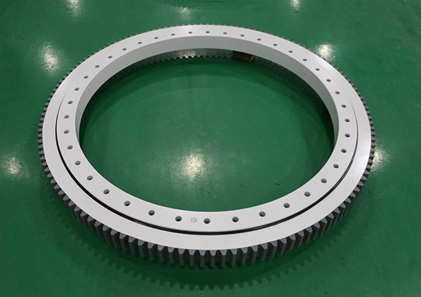Is the surface roughness of the slewing bearing as small as possible? How to choose?
Is the surface roughness of the slewing bearing as small as possible? Surface roughness refers to the small spacing and the unevenness of small peaks and valleys that the machined surface has. The roughness of the bearing surface may affect the wear resistance, stability, fatigue strength, stability and other properties of the bearing. Generally speaking, the smaller the roughness of the bearing surface, the better, but it should be determined according to the equipment use requirements and process accuracy.
The surface roughness of the slewing bearing is not as small as possible

Is the surface roughness of the slewing bearing as small as possible? It can be analyzed from the following aspects:
1. Physical properties of materials
The surface roughness of the bearing is often represented by Ra. Generally speaking, from the working principle, we hope that the smaller the surface roughness of the slewing bearing, the better. Generally, the higher the bearing tolerance accuracy level, the better the surface quality and the finer the workmanship. However, two surfaces that are too smooth are prone to gluing (exchange between the same or similar materials, which is similar to the “dyeing phenomenon” in our life, but it belongs to the exchange of metal substances here), while the surfaces that are too rough are prone to gluing. Under the action of force, the surface is prone to peeling off (that is, what we often call wear).
2. Processing cost
Theoretically, the smaller the value of the surface roughness of the slewing bearing, the better, the smaller the roughness, the smoother the surface and the more beautiful the appearance. However, the size of the roughness is determined by the machining process and other factors, such as the friction between the tool and the bearing surface, cutting, and high-frequency vibration in the process.
However, the smaller the surface roughness, the higher the processing cost. Whether the use cost of the part matches the consumption speed and the profit of the equipment production output value. These all need to be considered. Some spare parts do not have high requirements on the roughness of the bearing surface. Excessive pursuit of the surface roughness will affect the economy of processing.
Selection principle of surface roughness of slewing bearing

1. Economic perspective:
From an economic point of view, on the basis of meeting the performance requirements of the slewing bearing, the lower the accuracy, the better. This allows for lower production costs.
2. Use function:
(1) The roughness value of the working surface is smaller than that of the non-working surface.
(2) The roughness value of the friction surface is smaller than that of the non-friction surface.
(3) The roughness value of the clearance fit is smaller than that of the interference fit.
(4) The roughness of the mating surface should be equivalent to its dimensional accuracy requirements. The smaller the size, the smaller the roughness value should be.
(5) The roughness value of the surface subjected to cyclic load and the inner fillet and concave part where stress concentration may occur should be small.
Is the surface roughness of the slewing bearing as small as possible? I believe everyone is clear. The actual selection of bearing accuracy and surface roughness needs to be determined according to actual needs. In the case of ensuring bearing performance, cost control is also very important.


